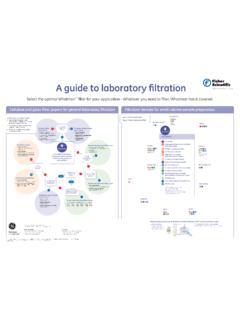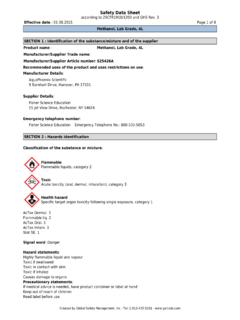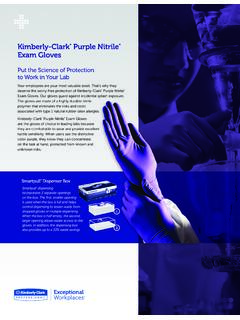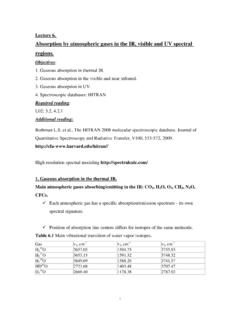Transcription of Standard Methods for the Examination of Water and ...
1 Standard Methods for the Examination of Water and Wastewater 22nd Edition TABLE OF CONTENTS Part 1000 INTRODUCTION 1010 INTRODUCTION A. Scope and Application of Methods B. Statistics C. Glossary D. Dilution/Concentration Options 1020 QUALITY ASSURANCE A. Introduction B. Quality Control C. Quality Assessment 1030 DATA QUALITY A. Introduction B. Measurement Uncertainty C. Method Detection Level D. Data Quality Objectives E. Checking Analyses Correctness 1040 METHOD DEVELOPMENT AND EVALUATION A. Introduction B. Method Validation C. Collaborative Testing 1050 EXPRESSION OF RESULTS A. Units B. Significant Figures 1060 COLLECTION AND PRESERVATION OF SAMPLES A. Introduction B. Collection of Samples C. Sample Storage and Preservation 1080 REAGENT Water A.
2 Introduction B. Methods for Preparing Reagent-Grade Water C. Reagent Water Quality 1090 LABORATORY OCCUPATIONAL HEALTH AND SAFETY A. Introduction B. Safe Laboratory Practices C. Laboratory Facility/Fixed Equipment D. Hazard Evaluation E. Personal Protective Equipment F. Worker Protection Medical Program G. Provisions for Work with Particularly Hazardous Substances H. Biological Safety I. Radiological Safety J. Chemical Hygiene Plan 1100 WASTE MINIMIZATION AND DISPOSAL A. Introduction B. Waste Minimization C. Waste Treatment and Disposal Part 2000 PHYSICAL AND AGGREGATE PROPERTIES 2010 INTRODUCTION 2020 QUALITY ASSURANCE/QUALITY CONTROL A. Introduction B. Quality Control Practices 2110 APPEARANCE 2120 COLOR A. Introduction B. Visual Comparison Method C. Spectrophotometric Single-Wavelength Method (Proposed) D.
3 Spectrophotometric Multi-Wavelength Method E. Tristimulus Spectrophotometric Method F. ADMI Weighted-Ordinate Spectrophotometric Method 2130 TURBIDITY A. Introduction B. Nephelometric Method 2150 ODOR A. Introduction B. Threshold Odor Test 2160 TASTE A. Introduction B. Flavor Threshold Test (FTT) C. Flavor Rating Assessment (FRA) 2170 FLAVOR PROFILE ANALYSIS A. Introduction B. Flavor Profile Analysis 2310 ACIDITY A. Introduction B. Titration Method 2320 ALKALINITY A. Introduction B. Titration Method 2330 CALCIUM CARBONATE SATURATION A. Introduction B. Indices Indicating Tendency of a Water to Precipitate or Dissolve CaCO3 C. Indices Predicting the Quantity of CaCO3 That Can Be Precipitated or Dissolved D. Graphical and Computer Methods for CaCO3 Indices 2340 HARDNESS A.
4 Introduction B. Hardness by Calculation C. EDTA Titrimetric Method 2350 OXIDANT DEMAND/REQUIREMENT A. Introduction B. Chlorine Demand/Requirement C. Chlorine Dioxide Demand/Requirement D. Ozone Demand/Requirement Batch Method E. Ozone Demand/Requirement Semi-Batch Method 2510 CONDUCTIVITY A. Introduction B. Laboratory Method 2520 SALINITY A. Introduction B. Electrical Conductivity Method C. Density Method D. Algorithm of Practical Salinity 2530 FLOATABLES A. Introduction B. Particulate Floatables C. Trichlorotrifluoroethane-Soluble Floatable Oil and Grease 2540 SOLIDS A. Introduction B. Total Solids Dried at 103 105 C C. Total Dissolved Solids Dried at 180 C D. Total Suspended Solids Dried at 103 105 C E. Fixed and Volatile Solids Ignited at 550 C F. Settleable Solids G.
5 Total, Fixed, and Volatile Solids in Solid and Semisolid Samples 2550 TEMPERATURE A. Introduction B. Laboratory and Field Methods 2560 PARTICLE COUNTING AND SIZE DISTRIBUTION A. Introduction B. Electrical Sensing Zone Method C. Light-Blockage Methods D. Light-Scattering Method 2570 ASBESTOS A. Introduction B. Transmission Electron Microscopy Method 2580 OXIDATION REDUCTION POTENTIAL (ORP) A. Introduction B. Oxidation Reduction Potential Measurement in Clean Water 2710 TESTS ON SLUDGES A. Introduction B. Oxygen-Consumption Rate C. Settled Sludge Volume D. Sludge Volume Index E. Zone Settling Rate F. Specific Gravity G. Capillary Suction Time H. Time-to-Filter I. Modified Settled Sludge Volume 2720 ANAEROBIC SLUDGE DIGESTER GAS ANALYSIS A. Introduction B.
6 Volumetric Method C. Gas Chromatographic Method 2810 DISSOLVED GAS SUPERSATURATION A. Introduction B. Direct-Sensing Membrane-Diffusion Method Part 3000 METALS 3010 INTRODUCTION A. General Discussion B. Sampling and Sample Preservation C. General Precautions 3020 QUALITY ASSURANCE/QUALITY CONTROL A. Introduction B. Quality Control Practices 3030 PRELIMINARY TREATMENT OF SAMPLES A. Introduction B. Filtration for Dissolved and Suspended Metals C. Treatment for Acid-Extractable Metals D. Digestion for Metals E. Nitric Acid Digestion F. Nitric Acid-Hydrochloric Acid Digestion G. Nitric Acid-Sulfuric Acid Digestion H. Nitric Acid-Perchloric Acid Digestion I. Nitric Acid-Perchloric Acid-Hydrofluoric Acid Digestion J. Dry Ashing K. Microwave-Assisted Digestion 3110 METALS BY ATOMIC ABSORPTION SPECTROMETRY 3111 METALS BY FLAME ATOMIC ABSORPTION SPECTROMETRY A.
7 Introduction B. Direct Air-Acetylene Flame Method C. Extraction/Air-Acetylene Flame Method D. Direct Nitrous Oxide-Acetylene Flame Method E. Extraction/Nitrous Oxide-Acetylene Flame Method 3112 METALS BY COLD-VAPOR ATOMIC ABSORPTION SPECTROMETRY A. Introduction B. Cold-Vapor Atomic Absorption Spectrometric Method 3113 METALS BY ELECTROTHERMAL ATOMIC ABSORPTION SPECTROMETRY A. Introduction B. Electrothermal Atomic Absorption Spectrometric Method 3114 ARSENIC AND SELENIUM BY HYDRIDE GENERATION/ATOMIC ABSORPTION SPECTROMETRY A. Introduction B. Manual Hydride Generation/Atomic Absorption Spectrometric Method C. Continuous Hydride Generation/Atomic Absorption Spectrometric Method 3120 METALS BY PLASMA EMISSION SPECTROSCOPY A. Introduction B. Inductively Coupled Plasma (ICP) Method 3125 METALS BY INDUCTIVELY COUPLED PLASMA/MASS SPECTROMETRY A.
8 Introduction B. Inductively-Coupled Plasma/Mass Spectrometry (ICP/MS) Method 3130 METALS BY ANODIC STRIPPING VOLTAMMETRY A. Introduction B. Determination of Lead, Cadmium, and Zinc 3500-Al ALUMINUM A. Introduction B. Eriochrome Cyanine R Method 3500-As ARSENIC A. Introduction B. Silver Diethyldithiocarbamate Method 3500-Ca CALCIUM A. Introduction B. EDTA Titrimetric Method 3500-Cr CHROMIUM A. Introduction B. Colorimetric Method C. Ion Chromatographic Method 3500-Cu COPPER A. Introduction B. Neocuproine Method C. Bathocuproine Method 3500-Fe IRON A. Introduction B. Phenanthroline Method 3500-Pb LEAD A. Introduction B. Dithizone Method 3500-Li LITHIUM A. Introduction B. Flame Emission Photometric Method 3500-Mg MAGNESIUM A. Introduction B. Calculation Method 3500-Mn MANGANESE A.
9 Introduction B. Persulfate Method 3500-K POTASSIUM A. Introduction B. Flame Photometric Method C. Potassium-Selective Electrode Method 3500-Se SELENIUM A. Introduction B. Sample Preparation C. Colorimetric Method D. Determination of Volatile Selenium E. Determination of Nonvolatile Organic Selenium Compounds 3500-Na SODIUM A. Introduction B. Flame Emission Photometric Method 3500-Sr STRONTIUM A. Introduction B. Flame Emission Photometric Method 3500-V VANADIUM A. Introduction B. Gallic Acid Method 3500-Zn ZINC A. Introduction B. Zincon Method 3500 OTHER METALS 3500-Sb Antimony 3500-Ba Barium 3500-Be Beryllium 3500-Bi Bismuth 3500-B Boron 3500-Cd Cadmium 3500-Cs Cesium 3500-Co Cobalt 3500-Ga Gallium 3500-Ge Germanium 3500-Au Gold 3500-In Indium 3500-Ir Iridium 3500-Hg Mercury 3500-Mo Molybdenum 3500-Ni Nickel 3500-Os Osmium 3500-Pd Palladium 3500-Pt Platinum 3500-Re Rhenium 3500-Rh Rhodium 3500-Ru Ruthenium 3500-Ag Silver 3500-Te Tellurium 3500-Tl Thallium 3500-Th Thorium 3500-Sn Tin 3500-Ti Titanium 3500-U Uranium Part 4000 INORGANIC NONMETALLIC CONSTITUENTS 4010 INTRODUCTION 4020 QUALITY ASSURANCE/QUALITY CONTROL A.
10 Introduction B. Quality Control Practices 4110 DETERMINATION OF ANIONS BY ION CHROMATOGRAPHY A. Introduction B. Ion Chromatography with Chemical Suppression of Eluent Conductivity C. Single-Column Ion Chromatography with Direct Conductivity Detection D. Ion Chromatographic Determination of Oxyhalides and Bromide 4120 SEGMENTED CONTINUOUS FLOW ANALYSIS A. Introduction B. Segmented Flow Analysis Method 4130 INORGANIC NONMETALS BY FLOW INJECTION ANALYSIS A. Introduction B. Quality Control 4140 INORGANIC ANIONS BY CAPILLARY ION ELECTROPHORESIS A. Introduction B. Capillary Ion Electrophoresis with Indirect UV Detection 4500 -B BORON A. Introduction B. Curcumin Method C. Carmine Method 4500 -Br BROMIDE A. Introduction B. Phenol Red Colorimetric Method C. (Reserved) D.










